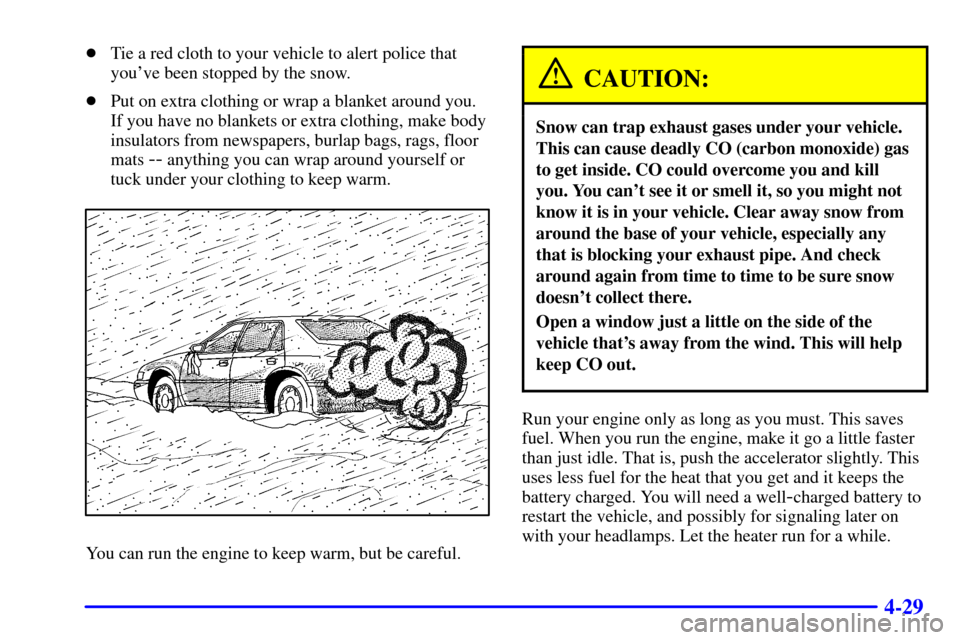Page 237 of 399

4-29
�Tie a red cloth to your vehicle to alert police that
you've been stopped by the snow.
�Put on extra clothing or wrap a blanket around you.
If you have no blankets or extra clothing, make body
insulators from newspapers, burlap bags, rags, floor
mats
-- anything you can wrap around yourself or
tuck under your clothing to keep warm.
You can run the engine to keep warm, but be careful.
CAUTION:
Snow can trap exhaust gases under your vehicle.
This can cause deadly CO (carbon monoxide) gas
to get inside. CO could overcome you and kill
you. You can't see it or smell it, so you might not
know it is in your vehicle. Clear away snow from
around the base of your vehicle, especially any
that is blocking your exhaust pipe. And check
around again from time to time to be sure snow
doesn't collect there.
Open a window just a little on the side of the
vehicle that's away from the wind. This will help
keep CO out.
Run your engine only as long as you must. This saves
fuel. When you run the engine, make it go a little faster
than just idle. That is, push the accelerator slightly. This
uses less fuel for the heat that you get and it keeps the
battery charged. You will need a well
-charged battery to
restart the vehicle, and possibly for signaling later on
with your headlamps. Let the heater run for a while.
Page 255 of 399

5-6
CAUTION:
Using a match near a battery can cause battery
gas to explode. People have been hurt doing this,
and some have been blinded. Use a flashlight if
you need more light.
Be sure the battery has enough water. You don't
need to add water to the ACDelco� battery
installed in every new GM vehicle. But if a
battery has filler caps, be sure the right amount
of fluid is there. If it is low, add water to take
care of that first. If you don't, explosive gas could
be present.
Battery fluid contains acid that can burn you.
Don't get it on you. If you accidentally get it in
your eyes or on your skin, flush the place with
water and get medical help immediately.
CAUTION:
Fans or other moving engine parts can injure you
badly. Keep your hands away from moving parts
once the engine is running.
5. Check that the jumper cables don't have loose or
missing insulation. If they do, you could get a shock.
The vehicles could also be damaged, too.
Before you connect the cables, here are some basic
things you should know. Positive (+) will go to
positive (+) or to a remote positive (+) terminal if the
vehicle has one. Negative (
-) will go to a heavy,
unpainted metal engine part or to a remote
negative (
-) terminal if the vehicle has one.
Don't connect positive (+) to the negative (
-) or you
will get a short that would damage the battery and
maybe other parts, too. And don't connect the
negative (
-) cable to negative (-) terminal on the
dead battery because this can cause sparks.
Page 256 of 399
5-7
6. Connect the red
positive (+) cable to the
remote positive (+)
terminal location on the
vehicle with the dead
battery. Use a remote
positive (+) terminal if
the vehicle has one.
7. Don't let the other end
touch metal. Connect it
to the positive (+)
terminal location of the
vehicle with the good
battery. Use a remote
positive (+) terminal if
the vehicle has one.
8. Now connect the black
negative (
-) cable to the
negative (
-) terminal
location of the vehicle
with the good battery.
Use a remote
negative (
-) terminal if
the vehicle has one.
Don't let the other end of the cable touch anything
until the next step. The other end of the negative (
-)
cable doesn't go to the dead battery. It goes to a
heavy, unpainted metal engine part or to a remote
negative (
-) terminal on the vehicle with the
dead battery.
Page 257 of 399
5-8
9. Connect the other end
of the negative (
-) cable
to the negative (
-)
terminal location on
the vehicle with the
dead battery. Your
vehicle has a remote
negative (
-) terminal
marked GND (
-).
10. Now start the vehicle with the good battery and run
the engine for a while.11. Try to start the vehicle with the dead battery.
If it won't start after a few tries, it probably
needs service.
NOTICE:
Damage to your vehicle may result from
electrical shorting if jumper cables are removed
incorrectly. To prevent electrical shorting, take
care that the cables don't touch each other or any
other metal period. The repairs wouldn't be
covered by your warranty.
Page 258 of 399
5-9
Jumper Cable Removal
A. Dead Battery or Remote Positive (+) Terminal
B. Good Battery or Remote Positive (+) and Remote
Negative (
-) Terminals
C. Heavy, Unpainted Metal Engine Part or Remote
Negative (
-) Terminal (GND)To disconnect the jumper cables from both vehicles,
do the following:
1. Disconnect the black negative (
-) cable the vehicle
that had the dead battery.
2. Disconnect the black negative (
-) cable from the
vehicle with the good battery.
3. Disconnect the red positive (+) cable from the
vehicle with the good battery.
4. Disconnect the red positive (+) cable from the
other vehicle.
5. Return the remote positive (+) terminal cover to
its original position.